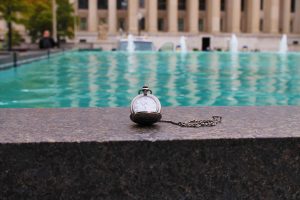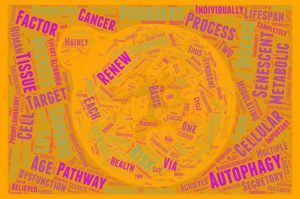Our cellular components and bodies inevitably become senescent, or in laymen’s terms – cells grow old. A client must practically find and drink from the proverbial “Fountain of Youth” to offset aging. She or he is more likely to offset “old man time” and the aging process with catabolic renewal or autophagy but there are a few approaches one can employ to stimulate cellular renewal and slow the aging process.

Photo by Casey Andersen via Unsplash
What is Autophagy?
Our evolving, applied knowledge of autophagy and its triggers can stimulate cellular renewal to counter senescence. When defining cell senescence (from the Latin word “senex” meaning old) and its awful afters, the National Cancer Institute stresses:
“senescent cells can build up… remain active…cause inflammation and damage to nearby healthy cells.”
This article summarizes
1. adverse cellular effects of human aging,
2. three methods that may promote longevity / anti-aging
3. types of exercise that stimulate autophagy.
Reversing Adverse Aging
We get older day by day, yet we do not need to acquiesce to “normal” aging processes as we age. Unfavorable “old” effects in our bodies include:
- unstable genes
- shortened telomeres
- nutrient-sensing malfunctions/metabolic syndrom (example: diabetes)
- mitochondrial dysfunction
- regenerative stem cell loss
- chronic inflammation
One group of researchers believe preventing the above aging disorders would be more successful by halting or reversing cell senescence rather than focusing solely on preventing the diseases they cause. Senolytics and senostatics, respectively, are substances that destroy dying cells making way for healthy cells to flourish and substances halt the effects of senescence-associated secretory phenotype (SASP)—a variety of bioactive molecules, including proinflammatory cytokines, chemokines, growth factors, and proteases secreted by senescent cells.
The following approaches are possible, plausible ways to fight senescent, zombie cells:
- Caloric restriction
- Exercise
- Geroprotective or senolytic/senostatic drugs (rapamycin, berberine, metformin as studied examples)
Note: Many recent “promising results” of anti-aging research are documented for simpler organisms than humans, namely yeast and rodents.

New and Promising Approaches to Cellular Renewal
- Biologist Yoshinori Ohsumi won the Nobel Prize in Medicine in 2016 by showing how simple organisms and cells recycle and renew their content, autophagy, with starvation or calorie restriction. Yes, cellular renewal is triggered by some, yet certainly not all stressors.
- A 2019 study published by the National Institute of Health highlighted exercise as a “potent geroprotector” in some studies.
- Recent [2019] research identified senolytic pharmaceuticals which may stimulate autophagy to slow biological aging.
1. Caloric Restriction
One physiological stressor, as triggered by energy equation debits, can stimulate autophagy as our natural recycling mechanism. Granted, some clients may not be excited by full fasting techniques or starvation which stimulates renewal, but time-restricted eating may be a more manageable and attractive approach.
While each client is different, an early dinner followed by a late break of the fast (with 14 hours as a benchmark) stimulates autophagy. This is one option for cellular and bodily renewal. One should bear in mind the delicate balancing act of caloric restriction (CR) and exercise timing so that vital muscle is not catabolized for fuel.
2. Exercise Promotes Cellular Renewal
Option two for cellular renewal, exercise is clearly a prime consideration for professional trainers and their clients.
Appropriate, individualized programs can offset the consequences of age-related nutrient sensing and growth hormones. While certain human growth hormones downshift in aging processes, insulin secretions increase and healthy insulin sensitivity drops. Metabolic Syndrome (MetS), Pre-Diabetes, or Diabetes can result.
Three documented outcomes of focused exercise for cellular renewal are:
- A 2018 study of elder Korean women documented that their insulin resistance improved in a 12-week regimen of resistance bands and walking for 30 minutes three times weekly. We will skip hormonal and mechanistic details of how such exercises can promote long-term autophagy. A practical lesson is that autophagic exercise efforts in resistance and stamina are best started before insulin sensitivities increase and growth hormone secretions decrease with age.
- Another autophagic pathway study, involving the Silent information regulator 1 (Sirt-1) messenger, suggested that “both young and old” subjects gained skeletal muscle “after one bout of intense treadmill exercise.” This pathway for cellular recycling/renewal is the process for which a natural compound found in dark grapes, resveratrol, is also studied for its anti-inflammatory and dietary properties. Note: More studies for stimulated human benefits are suggested before autophagy benefits of resveratrol or other “geroprotective” compounds like metformin are conclusive.
- “In a recent randomized controlled trial, endurance training and interval training (but not resistance training) were found to promote telomerase activity and telomere length, essential markers for cellular senescence, regenerative capacity, and healthy aging.”
[sc name=”breast-cancer” ][/sc]
3. Pharmaceuticals May Also Renew
Options one and two are organic client methods to trigger cellular renewal.
Some pharmaceutical interventions have demonstrated the ability to therapeutically offset human aging. Researchers have recently detailed two mechanisms which may:
- target senescent cells apoptosis (senolytics)
- tune bodies to offset inflammatory responses to stressors (senostatics).
In theory, these pharmaceuticals may increase human tissue renewal processes or limit tissue dysfunctions from aging stressors. More laboratory and clinical research of these pharmaceutical classes are warranted.
Summary
We know that autophagy serves a key role in stretching both human healthspan and lifespan when triggered by three processes.
Yes, chosen stressors are needed to stimulate clients’ cellular renewal processes as they age.
- Caloric restriction or fasting is a tried, and true option if a client can establish and maintain a lifestyle for timely eating to live, rather than living to eat.
- Exercises, from both resistance and endurance activities, can favorably stress our chemical and hormonal messaging systems to sustain growth and defer or limit long-term senescence.
- Senolytic or Senostatic pharmaceuticals may prove to be non-organic boosts to cellular renewal in humans.
Each client’s commitment to caloric reduction, exercise, and possibly pharmaceuticals is different.
Thus, each trainer’s approach for a client who wants to offset senescence should be individualized too.
Clients have to get older, they do not have to get old.
Dave Frost has served the fitness community as a NFPT-certified CPT since 2013, and a Master Fitness Trainer since 2019.
As a Medicare-aged baby boomer, he specializes in training those clients who intend to stay “well past forty”.
He is a former world champion in Masters Rowing and National Indoor Rowing champion for his age group. He is also a group fitness instructor for The Row House. His website is https://wellpastforty.com. Dave recently published his work: KABOOMER: Thriving and Striving into your Nineties to promote stamininety for those intending to add years to their lives and life to their years.

